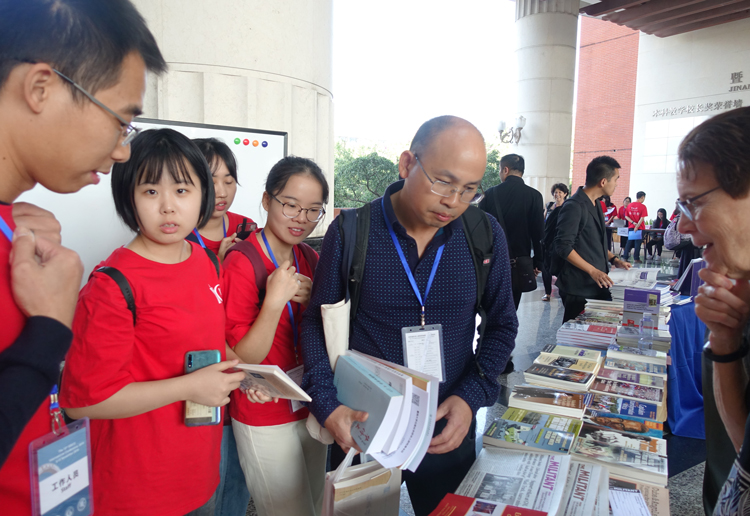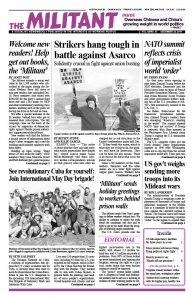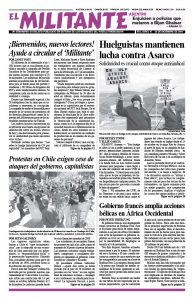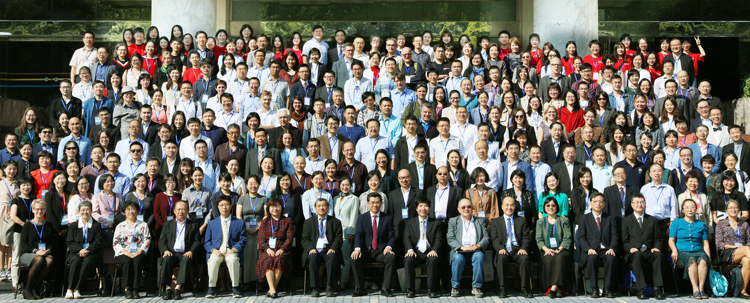GUANGZHOU, China — “Chinese Overseas and China: Through a Global Lens” was the theme of the 10th International Conference of ISSCO, the International Society for the Study of Chinese Overseas, that took place at Jinan University here Nov. 8-11. Concern over fallout for the millions of Chinese living elsewhere around the globe from the sharpening economic and political confrontation — still in its early stages — pitting the governments of the United States and its imperialist allies against the People’s Republic of China was the thread that ran through both plenary sessions and over 50 panel discussions.
“The rise of China and the West’s reaction to that rise” is putting the spotlight on overseas Chinese everywhere, stressed Peter Li, retired professor of sociology at the University of Saskatchewan as he closed the conference. “Chinese overseas” includes both recent waves of emigrants, and those whose ancestors long ago put down roots and built new lives in other countries, combating discrimination and oppression in order to do so — conditions they still have to deal with today.
Three hundred people, including 80 student volunteers, attended the conference. About half hailed from mainland China. The rest came from 25 other countries and the Special Administrative Regions of the PRC, Hong Kong and Macau. English and Chinese were the official languages of the conference with plenary sessions and nearly half of the panels conducted in English.
ISSCO was founded in 1992, in the wake of the post-Cultural Revolution political course initiated by Chinese leader Deng Xiaoping that opened China to foreign investment and capitalist enterprise. It became possible for Chinese academics living and working outside China to meet and collaborate with their peers in the PRC, bringing the study of Chinese overseas out of its neglected corner.
International conferences, held every three years since then, have taken place in Beijing, Hong Kong, Taipei, Singapore and elsewhere in Asia, as well as the United States, Denmark and Canada. A dozen smaller regional conferences have been organized as well, from New Zealand to Cuba, South Africa, Korea and beyond.
PRC’s growing muscle
The opening session of the conference focused on remarks of welcome from outgoing ISSCO President Tan Chee-Beng and the conference hosts — the School of International Studies/Academy of Overseas Chinese Studies of Jinan University and the national China Institute for Chinese Overseas Studies. They were followed by a “keynote forum” of five ISSCO leaders discussing the challenges faced by Chinese populations in five different regions of the world in light of the rising economic and military power of China.
“The relations between China and the Chinese overseas become more important as China rises in the world,” said Professor Lin Rupeng, the Communist Party secretary at Jinan University, in his welcoming remarks. “Academics,” he added forcefully, “have an important role to play in helping maintain the social stability of Hong Kong and Macau.”
There were no other references on the conference floor to the many months of protests in Hong Kong.

The panel that followed, one of the highlights of the conference, was chaired by Zhang Zhenjiang, dean of the School of International Studies/Academy of Overseas Chinese Studies. It was opened by Ling-Chi Wang, retired professor of Asian American and ethnic studies at the University of California in Berkeley, talking about Chinese in the U.S. He emphasized that the fast-growing Chinese American population has undergone enormous changes since 1965, when the U.S. government eliminated the last of the regulations that constituted a Chinese exclusion policy first enacted on a national level in 1882.
Before 1965 “95% of immigrants were from the Pearl River Delta in southern China,” said Wang, who co-founded ISSCO with Professor Wang Gung-Wu of the National University of Singapore. “Today, however, people of Chinese origin come from all provinces, as well as Taiwan, Vietnam and Hong Kong.”
Chinese ancestry notwithstanding, Wang stressed, Chinese-Americans are “not homogeneous. They’re extremely diverse and can’t be united on any ‘China issue.’”
Secondary migrations
Kee Pookong from Melbourne University spoke about the secondary immigration of “Chinese coming to Australia from Southeast Asian countries such as Malaysia where their families have been assimilated for generations.” Today only 40% of Chinese Australians came directly from China, Kee said. He also noted the fears voiced by many Australians of China’s rising economic weight and said allegations concerning “Chinese influence in Australian politics have become a daily topic in the media.”
Longtime ISSCO leader Leo Suryadinata of Singapore’s Institute of Southeast Asian Studies called attention to the fact that “72%” of the more than 40 million people of Chinese ethnicity who live in countries outside mainland China, Hong Kong, Taiwan and Macau “are located in Southeast Asia.” They constitute more than 75% of the population of Singapore, and sizable minorities in Malaysia, Thailand, Indonesia and others.
The global picture was rounded out by Mette Thunoe from Aarhus University in Denmark speaking on Chinese immigration in Europe and Li Anshan from Peking University in China discussing Chinese emigration to Africa today, which is overwhelmingly individual Chinese entrepreneurs seeking their fortunes.
Painting the picture of the diverse character of Chinese immigrant populations around the world brought home the fact that the overwhelming majority are not temporary “sojourners” who will one day return to China. They remain proud of their Chinese heritage, but are part of the permanent social and economic fabric of the countries where they and their families have settled.
Tension between China, imperialism
At the same time, as many of the conference panels documented, the growing tensions between China and the dominant imperialist powers mean that Chinese living abroad more often find themselves being held accountable for the local consequences of Beijing’s policies. And more are coming under attack for that reason.
For example, in her presentation entitled “Calling in the Cavalry: Chinese Overseas and Their Envisaged Role in the Belt and Road Initiative,” Mette Thunoe noted that Beijing policy is to enlist wealthy overseas Chinese to help overcome local opposition to the initiative. The BRI, as it is called, is built around Beijing providing billions of dollars in loans to governments around the world to finance Chinese state-supported construction companies to build ports, railroads and other strategic infrastructure projects along the millennia-old land and sea routes of Chinese traders.
For Beijing, said Thunoe, Chinese overseas are potential “agents for China’s foreign policy,” as well as sources of capital for economic development in China.
In one of several panels covering issues in the Philippines, Teresita Ang See of Manila’s Kaisa Heritage Center and Rommel Banlaoi of the Philippine Association for Chinese Studies, documented the substantial rise in the number of Chinese immigrants to the Philippines in recent years. Most, they said, find work with gambling cartels, especially online gambling, which is legal in the Philippines but not China. There is growing fear among Tsinoys, or Chinese-Filipinos, that they will become “collateral damage,” Ang See said, amid anger aimed at newer Chinese immigrants who are blamed for rising crime rates linked to gambling and drugs.
Still worse, said Ang See and Banlaoi in their joint presentation, is the “great distrust” with which Chinese in the Philippines tend to be viewed as Beijing and Manila face off over territorial claims in the South China Sea.
When challenged that their presentation cast Beijing’s policies in too negative a light, Ang See noted that was the topic of the panel: “New Chinese Immigrants in the Philippines: Racial Conflicts and the Security Dilemma.”
Surveillance by Washington and Ottawa
In his keynote address to the closing session of the conference, Peter Li pointed to the increased surveillance of Chinese scientists, engineers, researchers and students working in the U.S. by the FBI, employers and university administrators.
More than 180 researchers at 70 medical schools are now under investigation over alleged “theft of intellectual property,” he reported, citing information published in the New York Times, the U.K. Guardian and other sources. Temple University physicist Xiaoxing Xi was one of several who have been arrested, charged with espionage, and then exonerated, Li said.
Increased surveillance is not limited to the U.S., however. Li also spoke of Dr. Xiangguo Qiu, who was removed from the infectious disease lab at the University of Manitoba in Canada in the midst of an investigation of her security clearance by the Royal Canadian Mounted Police. Her husband, Keding Cheng, and an unknown number of her students from China were under investigation at the same time.
There is growing concern, even “panic,” said Li, among immigrants from China employed in various scientific fields and information technology. They fear things will get worse.
Following the closing ceremony, a Special General Meeting of ISSCO members elected a new board of directors and officers, naming Li Minghuan of the Academy of Overseas Chinese Studies of Jinan University the new president.
Student volunteers from Jinan University played a big part in ensuring the conference’s success. Among many other tasks, they helped oversee the busy courtyard of Jinan’s Main Teaching Building where several publishers, including the academic publisher Brill, Jinan University Press, the Kaisa Heritage Center and Pathfinder Press were provided space for tables stacked with hundreds of books for display and sale.
The steady traffic of students, teachers and conference participants kept the tables busy, and volunteers staffing the Pathfinder table reported that almost every one of the 140 books available was gone by the end of the conference. The best selling title, available in both English and Chinese, was Our History Is Still Being Written: The Story of Three Chinese Cuban Generals in the Cuban Revolution by Armando Choy, Gustavo Chui, and Moisés Sío Wong.
A visit to the on-campus museum dedicated to the history of Jinan University was one of the conference high points. It provided a window into the history of the class struggle in China through the tumultuous years of the 20th century, starting with the bourgeois democratic revolution that brought down China’s last imperial dynasty in 1911. Among other important pieces of that history, the museum displays cast a spotlight on the founding of Jinan University in 1906 as part of the fight to extend education to the toiling masses of China, one of the driving forces of that revolutionary struggle.
Daylong tours to some of the great historical and cultural sites of Guangzhou, the port city at the heart of the Pearl River Delta, and the surrounding region concluded conference activities.
A coming issue of the Militant will feature the conference panel presentation by Socialist Workers Party leader Mary-Alice Waters, president of Pathfinder Press, “Chinese Cubans in Cuba’s Revolutionary History and Relations Between China and Cuba Today.”


